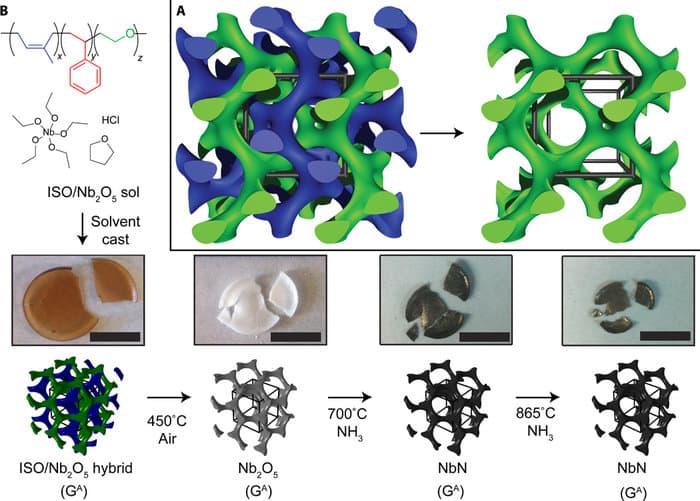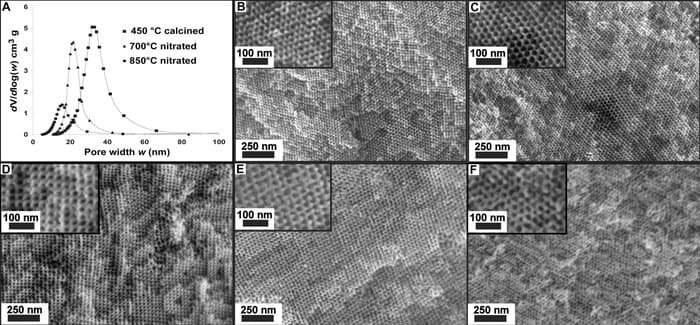Cornell Researchers Create World's First Self-Assembled Superconductor
Ulrich Wiesner and his team at Cornell University have developed a self-assembled super conductor, niobium nitride (NbN) inside a 3D gyroidal structure. This is the first time in history that a self-assembly of superconductors has been engineered. The details of this research have been reported in the Science Advances Journal on 29th January.
The gyroid is a complex cubic structure comprising infinitely connected triply periodic minimal surfaces. Superconductors with a periodical meso-porous backbone display manipulative properties that modify various characteristics of ideal superconductors.

GA structure and sample/structure evolution from initial compounds to final NbN superconductors
Wiesner explained that there would be a revolution in the existing MRI technology if the team's current goal of producing superconductors at higher temperatures could be realised. Magnetic Resonance Imaging uses magnetic Super conductors that take the help of helium and nitrogen as coolants. It is believed that by using such a superconductor, several of its applications would get a major boost in efficiency and productivity.
The current research is the output of two decades of collaborative work between Wiesner and Sol Gruner. The most significant decision was that of choosing NbN as the superconductor material. Weisner’s team had initially used organic block copolymers to structure direct sol-gel niobium oxide (Nb2O5) into three-dimensional alternating gyroid networks by solvent evaporation induced self-assembly. The group built two intertwined networks, one of which was melted in air at 450 degrees Celsius.

Materials Characterization
To achieve superconductivity, the NbN was slowly heated to 850 degrees Celsius in a two-step process. At first, the temperature was built up to 700 degrees Celsius and then cooled, followed by once again raising the temperature to 850 degrees Celsius.
Wiesner also elaborated that the block copolymer self-assembly is considered a hallmark of soft condensed matter physics. It can generate new types of superconducting structures and composite materials opening up scopes for sophisticated biomedical devices.
Watch 3D gyroid structure:
Sources: #-Link-Snipped-# | #-Link-Snipped-#
The gyroid is a complex cubic structure comprising infinitely connected triply periodic minimal surfaces. Superconductors with a periodical meso-porous backbone display manipulative properties that modify various characteristics of ideal superconductors.

GA structure and sample/structure evolution from initial compounds to final NbN superconductors
Wiesner explained that there would be a revolution in the existing MRI technology if the team's current goal of producing superconductors at higher temperatures could be realised. Magnetic Resonance Imaging uses magnetic Super conductors that take the help of helium and nitrogen as coolants. It is believed that by using such a superconductor, several of its applications would get a major boost in efficiency and productivity.
The current research is the output of two decades of collaborative work between Wiesner and Sol Gruner. The most significant decision was that of choosing NbN as the superconductor material. Weisner’s team had initially used organic block copolymers to structure direct sol-gel niobium oxide (Nb2O5) into three-dimensional alternating gyroid networks by solvent evaporation induced self-assembly. The group built two intertwined networks, one of which was melted in air at 450 degrees Celsius.

Materials Characterization
To achieve superconductivity, the NbN was slowly heated to 850 degrees Celsius in a two-step process. At first, the temperature was built up to 700 degrees Celsius and then cooled, followed by once again raising the temperature to 850 degrees Celsius.
Wiesner also elaborated that the block copolymer self-assembly is considered a hallmark of soft condensed matter physics. It can generate new types of superconducting structures and composite materials opening up scopes for sophisticated biomedical devices.
Watch 3D gyroid structure:
Sources: #-Link-Snipped-# | #-Link-Snipped-#
0

